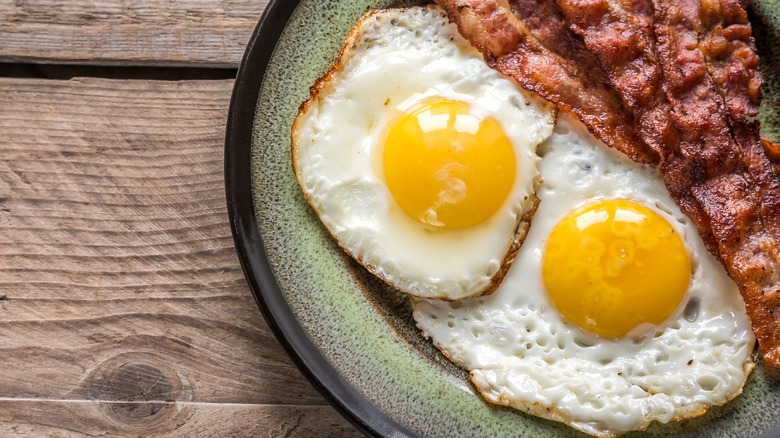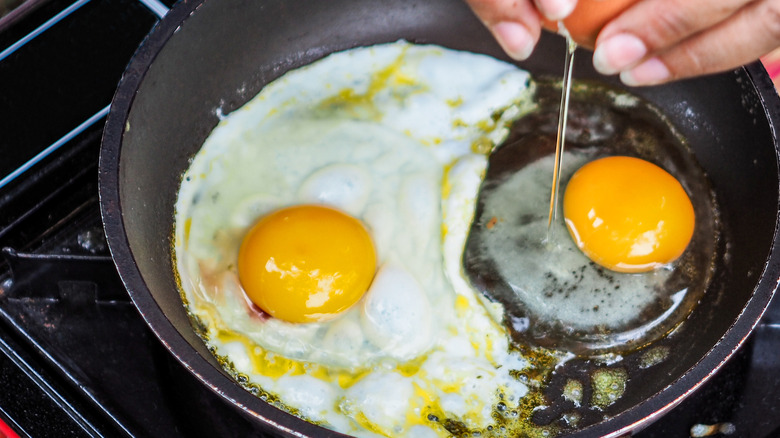The Olive Oil Technique For Perfectly Crispy Fried Eggs
There are few foods on this earth more versatile than the egg, and of all the (seemingly endless) ways to cook one, there are few variations more comforting and delicious than the fried egg. It's an absolute classic. Sop it up with a buttery piece of toast, eat it with crispy bacon or salty potatoes, smash it between some meat and cheese on a breakfast sandwich, or throw it on top of a healthy bowl full of grains and veggies.
And there are even options when it comes to how a fried egg is cooked. The age-old question comes our way — "how do you like your eggs?" — and we've got to be ready to answer. You might choose sunny side up, over easy, over medium, or over hard. Some have a go-to order they never stray from; others mix it up and experiment with their eggs every which way.
This one goes out to all of us who are interested in a very specific type of fried egg — the crispy fried egg. An egg that is perfectly, completely laced with a golden brown layer of crisp on the bottom, and just set on top with a gooey, runny yolk. If that sounds like an egg you want to eat, you're in the right place.
Get your olive oil out for extra crispy fried eggs
In the case of the crispy fried egg, olive oil is your new best friend — so step aside butter and cooking spray. Those typical methods of frying an egg won't work here if your goal is to accomplish that lacy, crispy, crunchy coating. Everyone from The New York Times to Martha Stewart is making a version, but the technique is generally the same.
The key to making perfectly crispy fried eggs is to get that olive oil piping hot before the egg ever touches it. Cover your pan in a shallow layer of olive oil, about two tablespoons (you want enough that the bottom of the egg is submerged, but you don't want to drown it). Heat the oil over medium-high heat for about two minutes, until it reaches that shiny, shimmery, ripple-like state. Then crack your eggs into the pan, season them, and tilt and rotate the pan a bit as they cook, letting the oil pool around the eggs. It should only take about two minutes for the egg to crisp up on the bottom and set on top. If desired, you can spoon the hot oil onto the top of the egg to cook the whites a bit more. Pro tip: Use a fish spatula for easy removal.
In the end, the egg should be visibly laced in that bubbly golden brown around the edges, with a still-soft and runny yolk on top: a perfectly crispy fried egg.
Why olive oil?
Why does olive oil work best for this crispy goodness? First, it has a relatively high smoke point (according to OliveOil.com, butter has a smoke point of 350 degrees Fahrenheit, while Extra Virgin Olive Oil can reach up to 410 degrees. That means the egg can sizzle and fry to perfection before the oil starts to burn off and break down, whereas butter might burn by the time it gets there.
But like butter, olive oil has got a depth of flavor to it — whether bright, fruity, herbaceous, or earthy. So while you could technically crisp up your eggs in something like canola or avocado oil, those essentially flavorless oils or cooking sprays won't add to the tastiness of the egg like olive oil does. And lastly, olive oil is actually considered fairly healthy, with many known benefits like antioxidants and "good" fats. This makes it a great candidate to use for something like this, where you may need a generous amount of oil to create a little pool for the eggs to cook in.
Olive oil gets hot enough to crisp up your eggs, it's got the flavor profile to add to the dish, and it's a healthier alternative to butter and most other cooking oils. It's a win-win-win.


